Nick Collias, RKC, PCC, Senior Level Editor, Bodybuilding.com
By Adrienne Harvey, SrPCC, RKC-II, CK-FMS
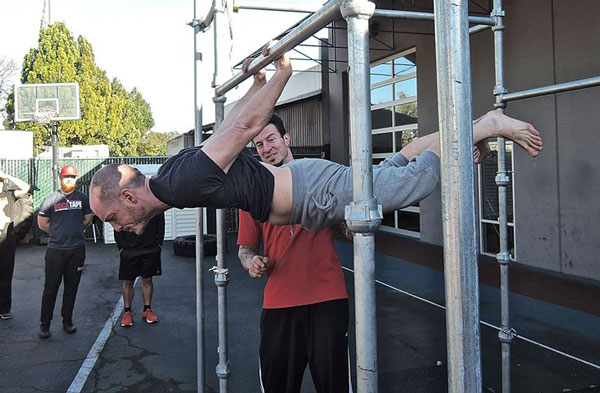
Dragon Door: What brought you to the fitness industry?
Nick Collias: I have been a writer and editor for a variety of publications and websites since my teenage years, ranging from newspapers to book publishing and translation. But for the most, I had been sort of committed to a "life of the mind" approach, and didn't really give a second thought to my body, except as it helped me play golf now and then.
Honestly, I grew up convinced that I was more or less a weakling. I played sports, but never made any forward progress in any of them, and never thought fitness was in the cards for me. I had always been a kind of wimpy and fairly physically intimidated guy, and had managed to avoid injury until a golf swing in my 20s tweaked my back. Since then it seemed like I would tweak it again every six months like clockwork, and I didn’t want to get trapped in that loop forever (as I have seen far to many of my acquaintances do). I realized I needed to get serious about strength training or I would just be paddling uphill for the rest of my life.
Then, about five years ago, I started to work for Bodybuilding.com, where I knew I would need to do a ton of fact checking and story generation. Knowing the type of editor and writer I am, I wasn’t interested in faking it. I wanted to build real expertise, and learn about fitness by working with accomplished fitness authors.
So, I started reading a ton of websites and books to find where I might fit in the larger strength and fitness conversation. Even though I work for Bodybuilding.com, I wasn't aspiring to be a bodybuilder. It's a demanding way to train and eat, and it doesn’t really match up with how I envision myself.
At some point, I found the classic
Dragon Door books, the
RKC, forum discussions and blog posts. I really liked the "only essentials" approach right away. Since I also wanted to have time to do things like trail running, golf, and playing with my kids, I knew that a six-day body part split wasn't something I could keep up with—even though many of my co-workers do.
Dragon Door: It also seems like Bodybuilding.com has grown to include many other aspects of fitness, strength, etc.
Nick Collias: Yes, it's been the most visited health and fitness website in the world for many years, which was a surprise to me before working here. The domain name doesn't really communicate the diversity of the people who read the site on a daily basis. While you can definitely come here for an arm workout, it's also a massive overall fitness experience.
My wife works for a health information website that focuses on patient instructions and behavior change, She says she envies me sometimes because we can be honest about many people’s goals. Yes, people want to improve their health, but most of them want to do it because on a certain level they want to feel and look good—and that matters. That can be more motivating than trying to focus on some arbitrary measure of strength, or something as nebulous as "health," and pretending that appearance doesn’t matter.
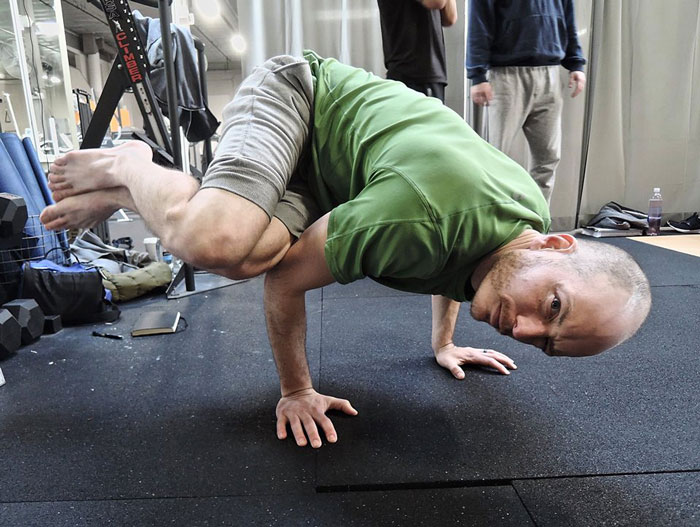
One thing I like about
Danny and
Al Kavadlo is that they have been working in gyms for years with so many different people, not just bodyweight strength freaks like them. Those guys both admit that how we look helps us define how healthy we feel. Looking good, feeling good and appreciating what our bodies can do is fundamental to Bodybuilding.com.
Personally, it took me a long time to realize that my body and mind are part of the same project that is my life. They aren't two competing entities that you have to choose between. Whether you sit inside writing, or are out there running or playing sports, you do it with your body and mind. The more you get that, the better you are at both.
Dragon Door: How would you describe your role at BodyBuilding.com?
Nick Collias: I am a senior level editor and work with many different strength coaches and athletes on articles and videos scripts. I have worked with plenty of Dragon Door authors, including the
Kavadlos,
Max Shank,
Marty Gallagher,
Josh Henkin, and
Zach Even-Esh. I even once interviewed
Paul Wade—through email, of course.
One thing we’ve been able to offer historically is widespread exposure for smart coaches who have great ideas and are trying to build their fitness brand. About four years ago, I remember seeing an article by Al on a different website, and I thought that he should be writing for us. I reached out and now Al and his wife Grace, and his brother Danny, are all regular contributors to the site.
On the page, I help describe fitness and make it more approachable. And yes, it’s ironic that a lot of my work involves sitting on my duff writing about fitness all day. I’ve had to work to come to grips with that over the last five years, and preparing for the RKC and
PCC helped me get super systematic about finding time for training in my life. Now when I train, it actually makes my day more productive and I don’t feel like I am wasting time.
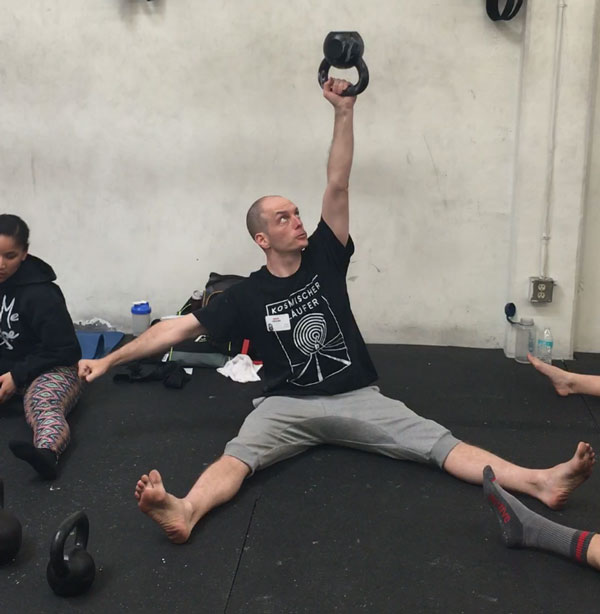
My work is incredibly supportive and understands that training during the work day actually helps employee performance—as long as you keep it reasonable, of course. We have a beautiful gym that we also use for photo shoots and videos. It even has a full set of
kettlebells. There’s a little crew of us that trains down there at lunchtime like clockwork.
Dragon Door: What inspired you attend the RKC workshop with Max Shank?
Nick Collias: It wasn't originally a goal of mine, because it didn’t seem like something that was in the cards for me. But when the opportunity arose about a year ago, I just took the chance. I
deepened my practice and at the same time gained more insight into the struggles people experience when they aren’t fitness athletes but aspire to elite physical goals.
After deciding to do the RKC, I had about a year to train for it. I had a great local trainer—an old RKC here in town named Matt "Griff" Griffith—who worked with me and become a very good friend. In our training, the first thing he did was a Functional Movement Screen, which was an eye-opener for me. It helped me establish a baseline then figure out what I needed to do.
I chose the RKC with Max because his approach is really interesting, and I wanted to train with him specifically. I knew that the time I would spend with him would be very valuable for my training, but also for my understanding of fitness on an editorial level.
An advantage the RKC offers over plenty of other certifications is direct access to personal instruction. It was a small, intimate group that met down at Kettlebells South Bay over the course of three days. I learned a ton about programming, and my limits, both at the workshop and as I was preparing for it.
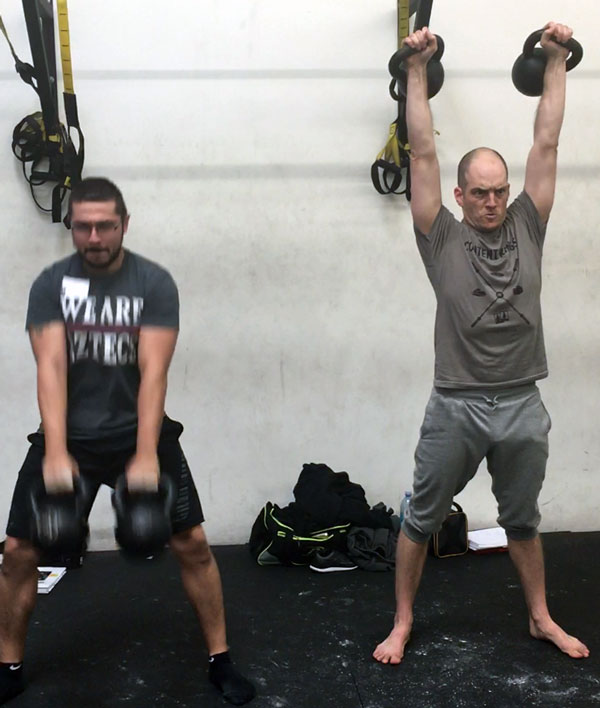
At the workshop, I was still somewhat terrified by the
RKC Snatch Test because I had not yet met that standard. But, I did my best, and the struggles I experienced contained valuable insights I could use in my job. It was a battle, but I easily passed the Snatch Test… with probably about 1/10th of a second left.
Dragon Door: Since earning your RKC certification, how has your approach to kettlebell training changed?
Nick Collias: When I started reading about kettlebells and the RKC approach, it appealed to me, but every time I went to a gym and tried to use them I would tweak something. I knew I needed to improve the way I was moving before I could earn the right to pick up a kettlebell. I am always telling people that
quality instruction matters so much with kettlebells.
At first I found an old
Dan John article somewhere—unfortunately I don’t remember where—about the value of rack pulls from the knee, so I started at that regressed point and did rack pulls and RKC planks for about six months. This helped me build the foundational grip strength, core strength, and muscular linkage to pick things up safely.
Then, I started to swing kettlebells, specifically a couple of cheap plastic ones I outgrew very quickly. Then I started working with my friend the kettlebell trainer, and everything started to come together. Now, I am sort of the "kettlebell guy" in the company. After the RKC, I started teaching a few classes and also taught my wife and my friends.
Kettlebells remain fundamental to the way I train. I also loved training for the PCC and use a lot of bodyweight exercises, but the kettlebell is still at the center. Oddly enough, given how much of a struggle the Snatch Test was for me, I fell in love with snatches afterward. Pretty much every Saturday since then has been "Snatchurday" at my house. I go into the garage, blare some epic, droney instrumental music and do (usually lightweight) snatches to my heart’s content.
Dragon Door: Recently you went to the PCC in Mountain View. Did you train for that in a particular way, and what brought you to the PCC?
Nick Collias: Because I have worked with Al and Danny on so many articles over the years, I was confident that the PCC would be a great experience. So, when that opportunity arose, I leapt at the chance to go to "Kamp Kavadlo" as I have been calling it around the office.
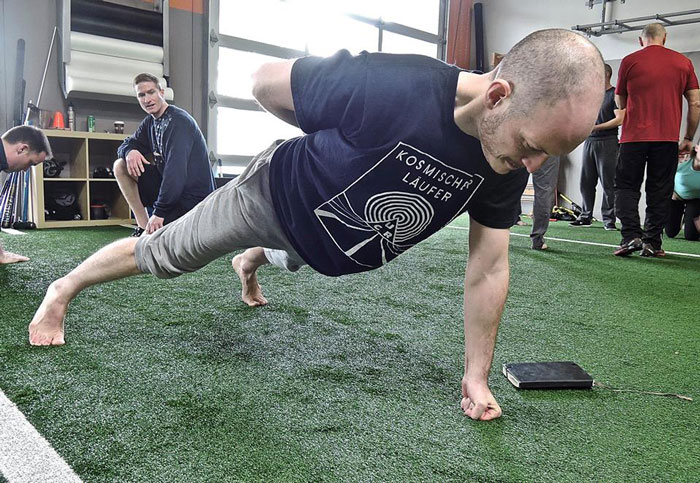
And it lived up to the name! It really is like a little camp for adults. The people who attended were so thrilled to be there, and so nice to each other, just like at the RKC. It was a fascinating window into another aspect of fitness. People came from all over the world to the PCC workshop.
While training for the PCC, I kept some kettlebells in the mix. When I was preparing for both the RKC and the PCC, I used a triple progression method. Over the years, I’ve found that it really works well for me to prepare for specific goals. At other points, I’ve done everything from "the same workout all the time" to a classic ABA alternating program. But, the triple progression method has worked best to allow me to build toward a few ambitious goals while still leaving room for recovery and life.
Each week, I have three solid full-body strength training days with different exercises on each day that feed into each other. For example I’ll have front lever practice on one day,
pull-ups on another day, and then lunges on a separate day from front squats. I’ll include some higher-rep assistance work on each of those days, time permitting, but the main course item is the highest priority. Then I also go to one or two yoga classes along with one or two runs each week. This helps me creep forward at a good sustainable pace.
I’ve also become a huge fan of Max Shank’s flow-style daily physical rituals, and I start each day with the intention of getting my flow on (after my espresso—nothing comes before the espresso). I used to be a "Netflix and foam roll" kind of guy, but I’ve found that moving that self-care to the morning makes everything that follows in the day more effective. Plus, getting into a nightly rolling ritual just led to daily TV watching, which isn’t really my thing.
For the PCC, I definitely changed my training a little bit, because I had two goals: Cruise through the
Century Test, and do one cool thing at the workshop itself.
I didn’t have any illusions that I would nail a human flag or anything, but I focused on front lever practice, skin-the-cats and hanging leg-raises, and muscle-up negatives, thinking that between those three, something would come together at the workshop.
Dragon Door: What ended up being your one cool move?
Nick Collias: I touched a back lever for a moment, even though I hadn’t really trained for it. I had practiced front lever regressions thinking that it would pay off with back levers as well.
While it was more of a controlled fall than a hold, I got it for a second. My one-arm pushup felt good at the workshop as well, which was great, because I had only been practicing it a little, and had tried to improve my numbers on traditional pushups instead.
The muscle-up still eludes me, but I don’t mind, because it’s never been a high priority. More than anything, making progress with the front lever was a good experience for me. I'm still not close to it, but in the little steps that I made, I saw that it’s a powerhouse movement for tying together your core, back, and butt. Achieving that power linkage had big payoffs for other exercises.
At the PCC itself, my front lever was actually less than what it had been in my training, because I was pretty tired at that point. Still, of all the moves in the curriculum, the front lever is the one that’s hanging out there and saying, "Come at me, bro." I didn't think I'd be able to skip ahead three steps to get the front lever at the workshop, but there was a lot of Kavadlo magic in the air...
Dragon Door: Having taught at many PCC workshops, we’ve sometimes seen someone do a move they’ve struggled with for 6-8 months after hearing the right combination of cues.
Nick Collias: Definitely. It seemed like people have transformative experiences at the PCC with the muscle-up in particular, because they have the strength, but need that last little skill element to get them over the bar for the first time. The right cuing from a great coach, and the right encouragement from a group standing around you, can definitely make a difference there.
It was interesting to see some of the guys who were very strong and experienced with bodyweight training doing fantastic lever progressions and
human flag progressions—but who were still nervous about the Century Test. I think they were concerned about being tired from the workshop. The Century Test is a really interesting PE experiment in that respect.
Dragon Door: Once in a while an absolutely standout performer who can just knock out muscle-up after muscle-up, will not pass The Century on the third day of the workshop. It's pretty rare, but it does happen!
Nick Collias: I noticed at the PCC that Danny and Al told everyone to keep their efforts at 70-80% max ,and focus on practice. The work load does sneak up, and I remember that from the RKC as well, so I took their advice to heart.
The RKC isn't bootcamp, but you do a ton of swings, and plenty of quick but intense workouts. On the first night of the RKC, I remember lying in my Airbnb bed and feeling muscles that I haven't felt for a while. On the second night, I wasn’t sure if I could move!
Max had a great approach, and while he pushed us hard, it was never too much. With the excitement of being at these workshops, limiting the intensity can be a big challenge for a lot of people!
Dragon Door: After the RKC and now the PCC, what's the next thing for you?
Nick Collias: I like to do a couple of trail races each year, usually among the big mountains in Idaho, where I live. I enjoy these challenges partially because I grew up in the country, and because the only fitness-related activity I through myself into as a teenager was a lot of hiking.
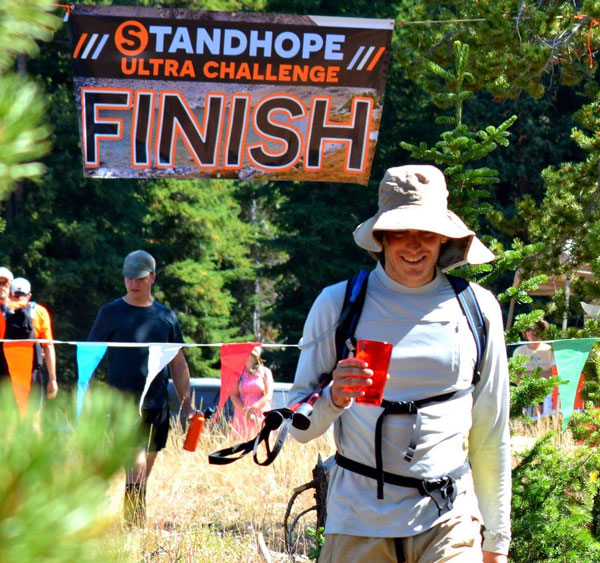
I also think that testing yourself against a mountain is the ultimate measure of fitness. Hiking or running in the mountains shows you exactly what muscles or energy systems still need to be developed. I take a very reasonable approach to these races and don’t care how long it takes me to finish. Honestly, it’s usually more of a brisk hike than what most people might consider a "race." One thing I love about running in the mountains is that no one cares about your time on a 20-mile mountain race—it’s just up to you. I keep a couple of these races on my calendar to keep myself honest.
I also recently organized an old-time strongman fair called "Strengthfort" as part of the annual Treefort Music Festival, which takes over downtown Boise for a week each March. We had steel shot-filled circus dumbbells, a few big stones from Idaho, and a pull-up jam with a couple of the
Bodyweight Master pull-up bars, among other things.
The stones were a great treat to train with. A friend and I attached bolts and rings to them for deadlifting in the classic Dinnie-stone style, which was a lift that few of the people who attended—even those who had competed in strongman events—had ever tried. Lo and behold, I found that the ring deadlift is basically just a giant kettlebell deadlift, only with a decreased ROM similar to my old friend the rack pull. It felt familiar and safe enough to go heavy on, and plenty of people who otherwise may have been intimidated by barbells or gym-based training surprised themselves with what they could do.
My friend Griff, the kettlebell trainer who had helped me earlier, was a co-conspirator for the event and told me afterwards that it was incredibly gratifying to see people—not "lifters" necessarily, but people—playing safely with heavy things. It was our own little camp for adults (and plenty of kids) for a single afternoon, and ended up being an eye-opener for many of the people who attended.
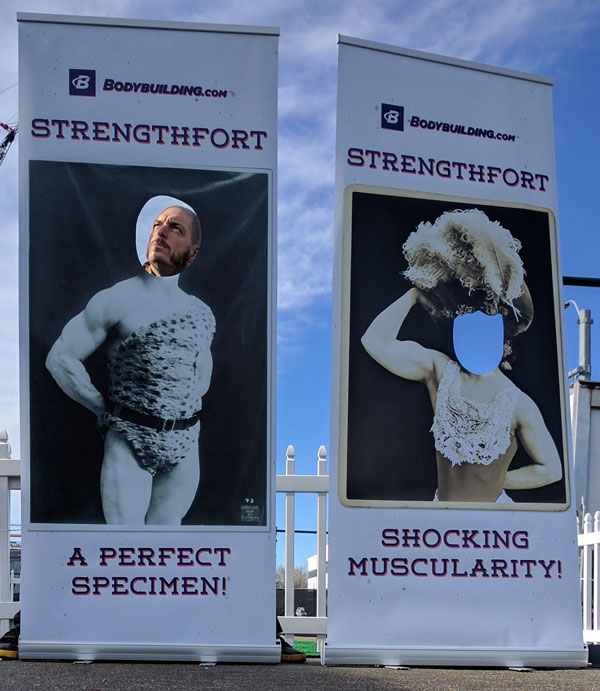
I also hope to start doing a little more local personal training over time. While the "doing" part of training is essential, I’ve found that teaching and sharing is equally essential. Passing along what I’ve learned at the RKC and PCC, and helping people understand how make it work for their specific circumstances and challenges, has already taught me a ton about how to move. Since my job is helping tell fitness stories and explain fitness ideas, this educational journey has been immensely helpful.
But more than any professional benefit, this is also all about showing my two young sons, and myself, that we're not permanently bound to the narratives we set for ourselves. My life was totally unbalanced; now it feels far more complete, but only because I was willing to set my ego aside and do the hard, often humiliating work of getting better at things I was bad at. Despite their many differences, that's an idea that runs deep through Bodybuilding.com, the RKC, and the PCC alike.
Back